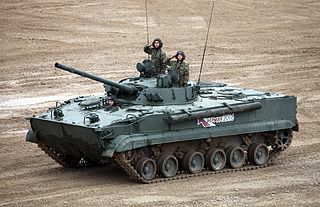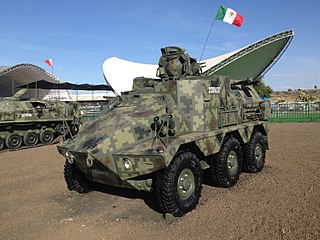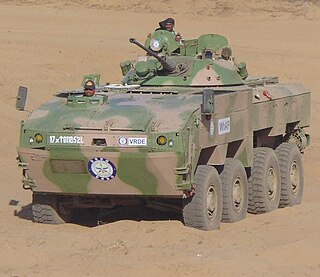
An armoured fighting vehicle or armored fighting vehicle (AFV) is an armed combat vehicle protected by armour, generally combining operational mobility with offensive and defensive capabilities. AFVs can be wheeled or tracked. Examples of AFVs are tanks, armoured cars, assault guns, self-propelled artilleries, infantry fighting vehicles (IFV), and armoured personnel carriers (APC).

The BMP-3 is a Soviet and Russian infantry fighting vehicle, successor to the BMP-1 and BMP-2. The abbreviation BMP stands for Boevaya Mashina Pekhoty.

The Mowag Piranha is a family of armoured fighting vehicles designed by the Swiss company Mowag.

The Wiesel Armoured Weapons Carrier (AWC) is a German light air-transportable armoured fighting vehicle, more specifically a lightly armoured weapons carrier, produced by Rheinmetall.

The Véhicule de l'Avant Blindé or VAB is a French armoured personnel carrier and support vehicle designed and manufactured by Renault Trucks Defense. It entered French service in 1979 and around 5,000 were produced for the French Army as well as for export. It has seen combat in various conflicts in Africa, Asia as well as Europe and has also been exported to more than 15 countries.

The FV432 is the armoured personnel carrier variant in the British Army's FV430 series of armoured fighting vehicles. Since its introduction in the 1960s, it has been the most common variant, being used for transporting infantry on the battlefield. At its peak in the 1980s, almost 2,500 vehicles were in use.

ACV-15 is the designation of an amphibious Infantry fighting vehicle family developed by the Turkish defense company FNSS Savunma Sistemleri A.Ş. This vehicle is also manufactured by DRB-HICOM Defence Technologies (DefTech). The design is an attempt to combine the capabilities of an infantry fighting vehicle (IFV) and an armoured personnel carrier (APC). The ACV-15 is based on the American Advanced Infantry Fighting Vehicle, which in turn is based on the American M113A1 armored personnel carrier.
A huge number of M113 Armored Personnel Carrier variants have been created, ranging from infantry carriers to nuclear missile carriers. The M113 armored personnel carrier has become one of the most prolific armored vehicles of the second half of the 20th century, and continues to serve with armies around the world in many roles.

On 29 November 1990, the adoption of United Nations Security Council Resolution 678 authorized the assembly of a multinational military coalition to fight against Iraq in the Gulf War. The coalition's purpose was to liberate Iraqi-occupied Kuwait by "all necessary means" if Iraq did not withdraw by 15 January 1991. Iraq failed to relinquish control over Kuwait by the deadline specified in Resolution 678, leading to the commencement of combat operations with the Gulf War aerial bombardment campaign on 17 January 1991. At this time, the coalition consisted of 42 countries and was spearheaded by the United States: the central command was led by the United States, Saudi Arabia, and the United Kingdom; the marine command was led by the United States; the Joint Forces East Command was led by Egypt, Saudi Arabia, Syria, Morocco, Kuwait, Oman, the United Arab Emirates, Qatar, Bahrain, Poland, and Czechoslovakia; and the Joint Forces North Command was led by the United States, the United Kingdom, France, Canada, Italy, Australia, Japan, and Turkey. On 23 February 1991, the aerial bombardment campaign came to an end as the coalition began a large-scale ground offensive into Iraqi-occupied Kuwait and parts of Iraq. The Iraqi military was devastated in the fighting, and Kuwait was declared completely free of occupying Iraqi troops on 28 February 1991.

The Panhard M3 VTT is an amphibious armoured personnel carrier. Developed as a private venture for the export market, the M3 was built with the same mechanical and chassis components as the Panhard AML range of light armoured cars. The two vehicle types share a 95% interchangeability of automotive parts. The M3 is an extremely versatile design which can be configured for a wide variety of auxiliary battlefield roles. The most popular variants of the base personnel carrier included an armoured ambulance, a mobile command post, and an internal security vehicle. It could also be fitted with a wide variety of turrets and armament, ranging from a single general-purpose machine gun to medium calibre autocannon.

The URO VAMTAC is a Spanish four-wheel drive military vehicle manufactured by UROVESA. Externally it is similar in appearance and design to the Humvee of the United States Military due to similar requirements. More than 2,000 of the vehicles have been delivered to the Spanish Armed Forces. Several other countries operate the VAMTAC as well, and it has seen service most recently in Afghanistan and Syria. The vehicle comes in three models, named I3, S3 and ST5, and has several configurations.

The Panhard VCR is a light armored personnel carrier (APC) designed by Panhard for the export market and later used by several countries. After Iraq ordered French turrets in September 1974 capable of launching antitank guided missiles (ATGM), the Panhard VCR was developed at the request of the Iraqis for vehicles with which to mate these ATGM-launcher turrets. This resulted in the largest order of VCRs, 100, for Iraq.
FNSS Savunma Sistemleri A.Ş. is a Turkish defense manufacturer founded in 1988. It is owned 51% by Nurol Holding of Turkey and 49% by British–American firm BAE Systems Inc., and operates facilities located in Gölbaşı, Ankara.

Tulpar is a Turkish heavy infantry fighting vehicle designed by the Sakarya-based automotive manufacturer Otokar. It is named after the Tulpar, a winged horse in Turkic mythology.

The VBM – Freccia is a family of 8x8 armoured vehicles that was designed and manufactured for the Italian Army by IVECO for the hull, the engine and the suspension, and OTO Melara for the armament. The first variant to be developed was the IFV, the Freccia being equipped with a Hitfist turret, the same as the one installed on the Dardo IFV.

The TATA Kestrel, also known as the IPMV , is a family of armoured personnel carriers developed by Tata Advanced Systems and the Defence Research and Development Organisation (DRDO). It was developed to replace Soviet-era BMP-1 and BMP-2 and APCs in service with the Indian Army.

The ZBD-03 or Type 03 is a Chinese airborne infantry fighting vehicle. It features a light-weight chassis and hydropneumatic suspension for airborne operations. Early prototypes received the designation ZLC-2000.



















